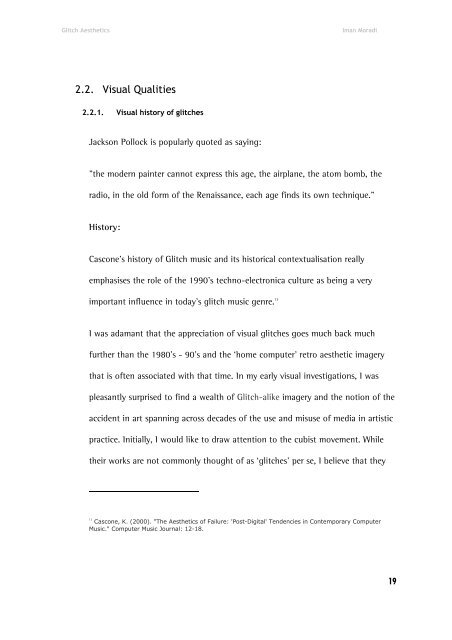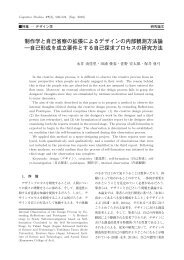Iman Moradi – Glitch Aesthetics
Iman Moradi – Glitch Aesthetics
Iman Moradi – Glitch Aesthetics
Create successful ePaper yourself
Turn your PDF publications into a flip-book with our unique Google optimized e-Paper software.
<strong>Glitch</strong> <strong>Aesthetics</strong><br />
<strong>Iman</strong> <strong>Moradi</strong><br />
2.2. Visual Qualities<br />
2.2.1. Visual history of glitches<br />
Jackson Pollock is popularly quoted as saying:<br />
"the modern painter cannot express this age, the airplane, the atom bomb, the<br />
radio, in the old form of the Renaissance, each age finds its own technique."<br />
History:<br />
Cascone’s history of <strong>Glitch</strong> music and its historical contextualisation really<br />
emphasises the role of the 1990’s techno-electronica culture as being a very<br />
important influence in today’s glitch music genre. 13<br />
I was adamant that the appreciation of visual glitches goes much back much<br />
further than the 1980’s - 90’s and the ‘home computer’ retro aesthetic imagery<br />
that is often associated with that time. In my early visual investigations, I was<br />
pleasantly surprised to find a wealth of <strong>Glitch</strong>-alike imagery and the notion of the<br />
accident in art spanning across decades of the use and misuse of media in artistic<br />
practice. Initially, I would like to draw attention to the cubist movement. While<br />
their works are not commonly thought of as ‘glitches’ per se, I believe that they<br />
13<br />
Cascone, K. (2000). "The <strong>Aesthetics</strong> of Failure: 'Post-Digital' Tendencies in Contemporary Computer<br />
Music." Computer Music Journal: 12-18.<br />
19





